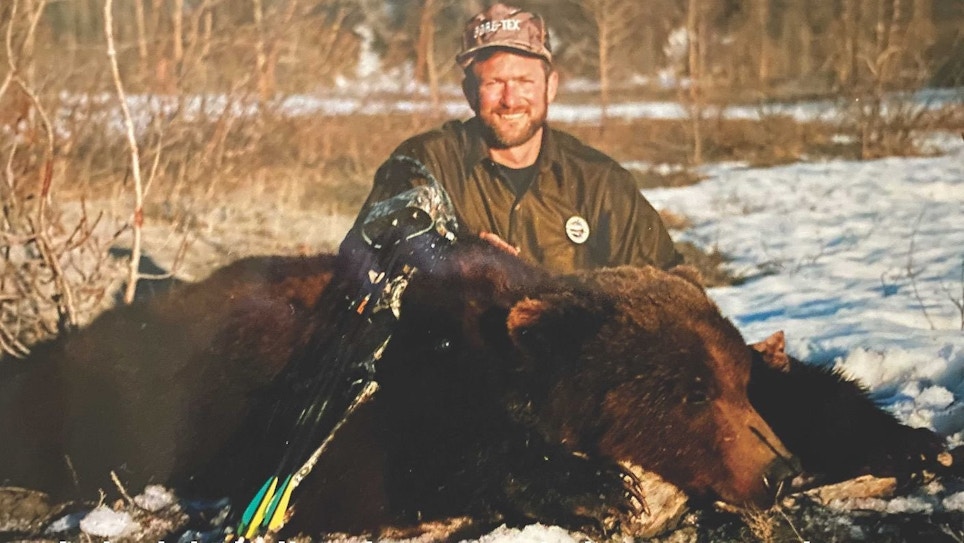In the journals of the historic Lewis and Clark expedition, Meriwether Lewis spent much time describing encounters with the great “white bear,” as they called the grizzly. Lewis noted that these “cantankerous bears” were just as likely to attack man as leave him alone. Though great hunters, he wrote, the Native Americans would never intentionally take on a grizzly, armed as they were with nothing more than a spear or longbow. Instead, they would band together in groups of between six and 10, hoping to accomplish with sheer numbers what they could never do alone.
“When the Indians are about to go in quest of the 'white bear,' previous to their departure they paint themselves and perform all of those superstitious rites commonly observed when they are about to make war on a neighboring nation,” Lewis wrote.
My first Alaska hunting trip occurred more than 30 years ago. I had licenses for the majestic caribou, the regal Dall sheep, and a mountain grizzly. All my friends envied my sheep license, yet deep inside, I was more excited by the chance to hunt the grizzly. I had read several historical accounts of grizzlies, including the Lewis and Clark journals, and was spell-bound by the seemingly impossible things men had seen these great bears do.
I took my first grizzly on that trip deep into the Wrangell Mountains, a large, dark-brown bear with long claws and a flawless hide. We spotted him ambling up a drainage one September afternoon. The weather was postcard perfect, the tundra a brilliant kaleidoscope of colors set against a backdrop of cobalt sky and snow-capped peaks. We tied the horses off, climbed the 60-degree slope and fought through the alders, breathlessly coming into an open slide the same time the bear did, not 75 yards away. When he stood up on his hind legs, I calmly raised my rifle, took aim -- and missed him by a mile. As he took off across the scree, I emptied the rifle, hitting him all three times through the chest as he raced into an alder thicket, where he expired. It took a week for the adrenaline rush to wear off. The memories never will.
Location, Location, Location
Hunting grizzly bears was once described to me as 95 percent boredom and 5 percent pure terror. That's a fair assessment. The boredom part comes with simply trying to locate a bear. This can take a lot of time or no time at all, depending on the turn of the cards.
Grizzlies are nomadic by nature; a biologist once told me they can have a home range of as much as 50 square miles, in which they may cover double-digit miles daily in search of food. This can make finding bears problematic.
In years of a strong fall blueberry crop, grizzlies tend to congregate on mountains that have large expanses of berry bushes. They also dig roots. In spring, they tend to follow the moose and caribou herds, preying heavily on newborn calves. Fresh grass shoots are a favored food in spring, too, on which the bears graze like cattle. At all times they'll expend hundreds of calories to excavate a low-calorie ground squirrel or marmot, which must taste like chocolate to them. But while they have their preferences, these omnivores will eat just about anything, including plastic cans filed with gasoline left on remote air strips by bush pilots, and even your tent.
It can get boring, glassing for days and never seeing a bear. When the weather is good, it isn't so bad. The wild country in which grizzlies thrive is the continent's most stunning, and there's always something to look at. When the weather turns sour and cold, however, wind-driven rain, sleet or snow eats its way under all your clothes, and it's hard to keep looking. But stay at it long enough, and the chances are that you'll be rewarded by the sight of a bear working along the mountainside. The sight of your first grizzly will never be forgotten.
Bow Bears
After moving to Alaska I thought, Why not bowhunt them? And so, after taking several grizzlies with a rifle, I did. But when I found a bear, questions crept into the back of my mind. After all, a grizzly is a threatening animal, one that, together with the coastal brown bear and the polar bear, is the only really dangerous game animal in North America. Your palms become a little sweaty, breathing a little faster, your heart begins to race. You know that you've seen the bear and he hasn't spotted you. Whose idea was this? you ask yourself. But the wind is right, and the bear has no idea you’re there. It shouldn't be any different than moving in for a shot at a deer back home. Right??
And yet, deep down inside, you know that it is different. Even the best grizzly hunt can go wrong — that's one of the reasons grizzly hunting is so special. You've read all the stories about wounded bears in the alders, of bear attacks and maulings, of chance encounters won by a bear. You begin to doubt your shooting ability, your courage. You ask yourself, Do I have what it takes?
Looking back, my first archery grizzly was really pretty routine. Hunting solo – nobody ever said I was the brightest bulb in the lamp – I found a bear, got in front of him, and when he passed within 35 yards I put a Thunderhead 125 through both lungs. He was done in 30 seconds. If it wasn’t that big a deal, though, why did it take 30 minutes for my wobbly legs to have the strength to support me when I tried to stand up?






